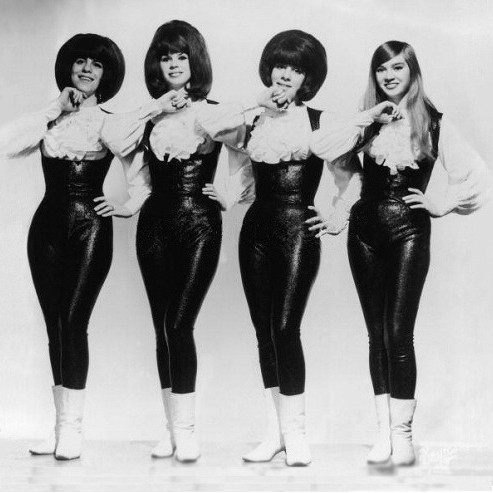“Leader of the Pack” by The Shangri-Las is more than just a song; it’s a cultural touchstone, a quintessential example of the “death disc” genre, and a defining track of the 1960s girl group era. Released in 1964, this melodramatic masterpiece captivated teenage audiences with its tale of forbidden love and tragic consequences, cementing its place in rock and roll history. This article delves into the story behind “Leader of the Pack,” exploring its creation, its impact, and the legacy of The Shangri-Las, the group who dared to deliver such raw emotion to the jukebox generation.
 The Shangri-Las
The Shangri-Las
From Doo-Wop Roots to Girl Group Glory: The Shangri-Las Emerge
To understand “Leader of the Pack,” we must first understand The Shangri-Las. Hailing from Queens, New York, the group comprised two pairs of sisters: Mary Weiss and Betty Weiss, and twins Margie Ganser and Mary Ann Ganser. Initially influenced by the harmonies of the Everly Brothers and the Ink Spots, they started singing together in their pre-teen years. Discovered and managed by Tony Michaels, they were briefly known as the Shangra-Las (a misspelling) before settling on the name Shangri-Las, inspired by a restaurant.
Their early recordings, like “Simon Says” and “Hate to Say I Told You So,” already hinted at their signature spoken word intros, a feature often attributed to producer Shadow Morton but evident in their work before him. These early tracks showcased their raw talent and set the stage for their breakthrough.
Shadow Morton: The Man Who Dialed Up the Drama
Enter Shadow Morton, a producer with a flair for the theatrical and a desire to emulate Phil Spector’s Wall of Sound. Morton, seeking his big break, connected with Ellie Greenwich, an old acquaintance who, along with Jeff Barry, was writing hits for Red Bird Records, a label founded by legendary songwriters Leiber and Stoller.
Morton famously pitched Barry and Greenwich “hit songs,” and when challenged, promised a “slow hit” by Tuesday. He enlisted the Shangri-Las, managed by his friend Tony Michaels, and on the way to the studio, conceived the melody for “Remember (Walkin’ in the Sand),” loosely based on The Modern Jazz Quartet’s “Sketch.”
The recording session for “Remember” was legendary, featuring a young Billy Joel on piano. Morton, draped in a cape and sunglasses, directed the session with dramatic pronouncements, asking for more “thunder” and “purple” in the music. Despite Billy Joel’s humorous anecdote about not getting paid, “Remember (Walkin’ in the Sand)” became The Shangri-Las’ breakthrough hit, reaching the top five and launching them into the spotlight.
 A jukebox, with the words
A jukebox, with the words
The Birth of a Teen Tragedy: Crafting “Leader of the Pack”
Following the success of “Remember,” The Shangri-Las needed a follow-up. Morton, along with Jeff Barry and Ellie Greenwich, crafted “Leader of the Pack.” Initially intended for another group, The Goodies, the song was ultimately given to The Shangri-Las, a decision that would solidify their status as queens of teen melodrama.
“Leader of the Pack” masterfully blended the “bad boy” trope prevalent in songs like “He’s a Rebel” with the burgeoning “death disc” trend. It opens with a Spector-esque grandeur, featuring a dramatic piano intro and Mary Weiss’s captivating lead vocals. The song tells the story of a girl falling for the “leader of the pack,” a motorcycle-riding rebel. However, unlike typical love songs, “Leader of the Pack” takes a dark turn.
The narrative unfolds with the girl’s father disapproving of her dangerous boyfriend, forcing her to break up with him. In a heart-wrenching spoken interlude, Mary Weiss delivers the devastating lines, culminating in the sound of a motorcycle speeding away and then a catastrophic crash.
“Look out! Look out! Look out!”: The Sound of Teenage Angst
The genius of “Leader of the Pack” lies in its sonic landscape, meticulously crafted by Shadow Morton. The song is punctuated by dramatic sound effects – the revving motorcycle, the screeching tires, the shattering crash – all designed to heighten the emotional impact. These sound effects, combined with the melodramatic narrative and Mary Weiss’s powerful vocals, created a visceral experience for listeners, perfectly capturing the angst and drama of teenage life.
“Leader of the Pack” became the epitome of the death disc genre, a trend that explored teenage anxieties and mortality through sensationalized narratives. Its success was so profound that it arguably marked the peak and subsequent decline of the genre, as no other death disc could quite match its dramatic heights. Even Twinkle’s “Terry,” released shortly after, felt like a direct imitation of “Leader of the Pack”‘s formula.
Chart-Topping Success and Cultural Impact of “Leader of the Pack”
“Leader of the Pack” soared to number one on the Billboard charts, solidifying The Shangri-Las’ place among the top American acts of the British Invasion era. The song resonated deeply with teenage girls, who saw their own romantic dramas and parental conflicts reflected in its narrative. It became an anthem of forbidden love and teenage rebellion, played endlessly on jukeboxes and radios across the nation.
The Shangri-Las, with “Leader of the Pack,” became known for their unique stage presence, choreographed arm movements, and captivating performances. Chris Curtis of The Searchers famously described their “weird presentation,” highlighting Mary Weiss’s detached delivery and the group’s synchronized gestures, further emphasizing the song’s theatricality.
Red Bird Records and the Shadow of the Mafia
The success of “Leader of the Pack” and The Shangri-Las was intertwined with the story of Red Bird Records. Founded by Leiber and Stoller, Red Bird partnered with George Goldner, a record label veteran with a knack for teen tastes but also a history of gambling debts and unsavory connections.
While Red Bird produced a string of hits, including “Chapel of Love” by The Dixie Cups and The Shangri-Las’ own records, Goldner’s financial troubles and alleged mafia associations cast a dark shadow over the label. Leiber and Stoller, increasingly concerned about Goldner’s practices, attempted to merge with Atlantic Records, hoping for oversight from their more reputable colleagues.
However, a disastrous meeting, fueled by Goldner’s drunken behavior and distrust, led to the collapse of the merger. Disillusioned and wanting to distance themselves from Goldner, Leiber and Stoller sold their shares of Red Bird to him for a mere dollar, effectively ending their involvement. Red Bird Records was eventually sold off, marking a premature end to a label that had briefly shone brightly in the mid-60s pop landscape.
The Shangri-Las’ Enduring Legacy Beyond “Leader of the Pack”
Despite the turmoil at Red Bird, The Shangri-Las continued to record, though subsequent singles like “Give Him a Great Big Kiss” and the dramatic “I Can Never Go Home Anymore” achieved moderate success but couldn’t replicate the chart-topping heights of “Leader of the Pack.”
The group faced further tragedy with the death of Mary Ann Ganser in 1970, and legal battles hampered their ability to record for a decade. While they attempted a comeback in the late 1970s with Seymour Stein of Sire Records, it ultimately fizzled out.
Despite the challenges and tragedies, the legacy of The Shangri-Las and “Leader of the Pack” endures. They are recognized as pioneers of the girl group sound, influencing generations of artists with their raw emotion, dramatic flair, and unapologetically teenage perspective. Mary Weiss, in her later years, fiercely defended the group’s artistic integrity, rejecting the “girl group” label and asserting their identity as rock and roll singers.
“Leader of the Pack” remains a timeless classic, a testament to the power of teen angst, melodramatic storytelling, and the enduring appeal of a song that dares to explore the darker side of young love. Its crashing motorcycle and heart-wrenching narrative continue to resonate, ensuring its place as a landmark song in rock and roll history and a defining moment for The Shangri-Las.


